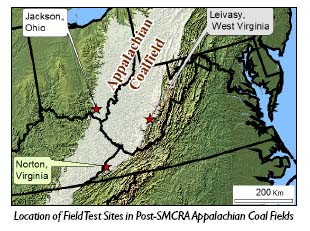
Carbon Sequestration
Terrestrial Project Descriptions
Restoring Sustainable Forests on Appalachian Mined Lands for Wood Products,
Renewable Energy, Carbon Sequestration, and Other Ecosystem Services
Project # 41619
Primary Performing Organization
Virginia Polytechnic Institute and State University
This project will estimate the carbon sequestration potential of mined lands with differing qualities using various reforestation methods. An inventory of mined lands available to be forested will be developed, the cost-per-ton of carbon sequestered by reforestation on mined lands will be estimated, and the total eastern U.S. mined-land carbon sequestration potential will be estimated under various scenarios. Social and ecological benefits associated with the reforestation of these mined lands also will be developed, such as the contribution reforestation may make to greenhouse gas mitigation. Areas in Virginia, West Virginia, Kentucky, Ohio, and Pennsylvania will be studied. See Map of field test site locations.

Current mining practices remove and burn the carbon-rich forest covering mine sites. Following coal removal, many eastern U.S. mine sites are reclaimed to grassland, which has only one-fifth the carbon sequestration potential of forestland. Preliminary estimates are that there is a potential for mined land forests to capture 250 to 290 tons of carbon per hectare over a period of 70 years.
The objectives of this project are to:
- Demonstrate and verify large-scale carbon sequestration by reforestation of mined lands, using high value tree species.
- Develop a forest site classification and mapping system for reclaimed mined sites.
- Complete a cost-benefit analysis of reforestation on these lands.
- Quantify the social and ecological benefits derived from these projects.
By meeting these objectives, this project will determine the biological and economic feasibility of restoring high-quality forests on mined land, and will measure carbon sequestration and wood production benefits achieved with restored forests.
Contact:
Project Manager: John Litynski, john.litynski@netl.doe.gov
Related Papers and Publications:
|